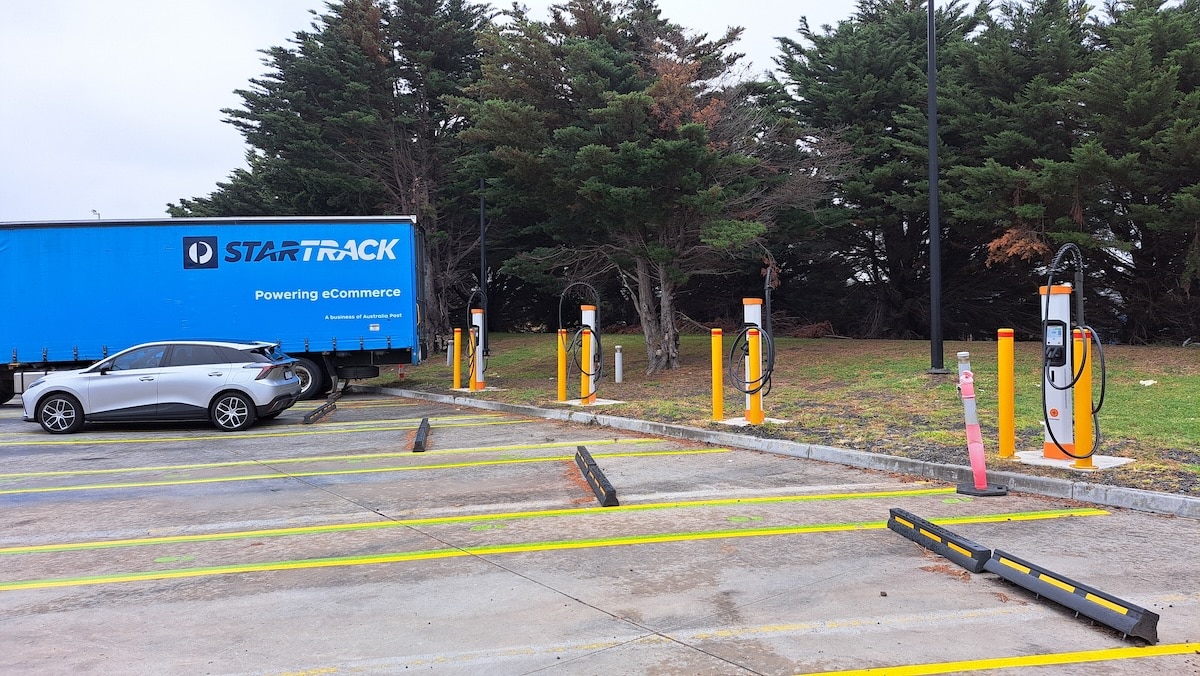Australia Post has installed new electric vehicle infrastructure at two of its sites in Melbourne with the help of the Victorian Department of Transport and Planning.
Australia Post has welcomed the opportunity to deploy new charging infrastructure and is committed to reducing carbon emissions from its business.
This means finding effective ways to decarbonise its large fleet of vehicles, including vans and trucks.
The initial focus has been in the last mile delivery with 5,131 electric delivery vehicles that cover 50 per cent of existing rounds.
The transaction from traditional hydrocarbon to low carbon battery electric vehicles is complex, especially given the size, diverse needs and required range of the Australia Post fleet.
Two of Australia Post’s major transport hubs in Melbourne have completed installation of new electric vehicle charging stations.
The project, funded under the Victorian Department of Transport and Planning’s CSIF grants program, was nearly two years in the making. Australia Post had initially invested in Fuso eCanters, the first battery electric trucks in the country.
These were wholly reliant on three-phase power or the equivalent of trickle charging.
“Through the CSIF program we knew we needed to install more sophisticated charging infrastructure,” recalls Peter Shelley, Australia Post Senior Manager for Decarbonisation Community, Sustainability and Stakeholder Engagement.
“This has enabled us to charge vehicles more efficiently. Previously charging was always overnight and not across shifts.”
JET Charge, who were awarded the tender for the project by Australia Post having previously worked in a consultative capacity, purchased Kempower rectifiers, a modular system popular in Europe.
Australia Post’s Sunshine West Parcel Delivery Centre and Dandenong Letter Centre each received one of the modular power systems that converts alternating current (AC) power into direct current (DC) power.
“Multi configurations can be designed and wired in a variety of different ways, so it’s really helpful when you work with a client and work out their requirements and work out the vehicles and what’s going to work best for them,” says Tyson Steel, JET Charge Project Manager.
“The individual port satellites are really quite compact and small and allow for these multiple configurations. You can install up to eight ports or eight separate satellites. One satellite can have two charging leads or a single.”
For this initial stage, Australia Post had JET Charge install a single cabinet at a charging capacity of 200kW with four single port satellites and provision for an additional four ports on the same system.
Being a niche area, the project undertaking was considered “split scope” according to Tyson, with a headworks electrician who provided upgrades upstream in order to facilitate the hardware requirements, working in close partnership with JET Charge.
Switchboards that would be used exclusively for the EV chargers were added, so too new positional cabling and concrete footings.
JET Charge also provides an inhouse load management system which is tried and tested.
The load management system integrates with a charger and the electrical supply to the switchboard. Its purpose is to ensure the charger is working within the limits of that capacity so that it doesn’t get overloaded.
An electric vehicle is commonly brought out to site by JET Charge and put under load to test all is working correctly.
Historically, Australia Post delivery vehicles have always reversed into the available parking bays at both depots. To accommodate this logistical function, a ten-metre cable was sourced in anticipation of bigger electric prime movers.
There is no public infrastructure available, at present, for charging battery electric trucks or large vans. It’s all but a zero-sum investment in mobile assets unless the fleets themselves commit to charging infrastructure on their own property.
“Our vans don’t typically fuel on site, so this is going to mean a complete transformation of the operations model required to support these types of vehicles,” says Peter.
The dependence on battery electric vehicles at this early juncture for the technology invites chicken or egg comparisons.
As Peter notes, it became evident the charging infrastructure is necessary first to enable the critical conversations with suppliers when it comes to trialling the efficacy of the product at some relevant scale.
“Without the infrastructure in place the trials are not going to be as successful,” he says. “Obviously, the difference between a 200kW charger and one that trickle charges overnight is going to result in a profound contrast in user experience and make for a very different application.”
Practical completion of the project happened in late November but not before some supply chain challenges needed to be overcome to get the rectifiers out of Finland in time.
“Australia Post really wanted all the works completed before December last year due to the high volumes of the Christmas period,” says Tyson.
“Our procurement team were able to engage with Kempower and use their logistics company to get it on an intercontinental ship and get it here just in time at the 11th hour.”
By concentrating on the Sunshine and Dandenong locations, Australia Post now has real-world data to draw from to plan its future strategy.
For the moment that might result in running battery electric vehicles between the two sites, or operating the units with longer ranges out to other sites and returning back to base. While these appear the most likely models in the short-term, Peter acknowledges there are some challenges to work through.
“Ultimately, for Australia Post as a whole, the question is whether we need chargers at all depot sites or whether we can rely on a central model, which is effectively how the current diesel re-fuelling works today,” says Peter.
Building up greater usage of each individual asset is one of the central concerns.
Outside of the more obvious metropolitan short haul task, how might regional locations such as Geelong, Ballarat and Bendigo be linked together? How many vehicles in those sites would make it worthwhile? Would a purpose-built centralised transport hub be a better long-term option?
These are all questions Australia Post is working through. Evolving technology is proving more sophisticated than what has been available over the past few years.
“You definitely feel you get some benefit from it as it continues to evolve,” says Peter.
“In the future it might be a 600kW facility with ten outlets. The way we set it up will depend on the availability of current or future charge capacity to support the requirements of the vehicles and other services that use that switchboard.”
Two different approaches are likely; utilise the 300amps the depots now have available in the short-term, with a longer-term view of upgrading switchboards and electrical capacity to support bigger electric vehicle projects. Peter says the financial model requires careful consideration.
“Do you buy or lease vehicles today especially considering the technology redundancy? It’s like buying a phone and knowing that in three years’ time the functionality may seem outdated,” he says.
“The battery product in 2030 is going to be very different to what it is today. We’ve already seen that with vehicles as later generations have double the range.”
Commercial vehicles in the EV market are already getting upgraded to carry greater capacity and over much longer ranges. The conundrum for fleet management is to avoid being stuck with a product that will be discontinued as superior versions arrive.
“We’ve been exploring that in our vans,” explains Peter.
“You really want models that can be introduced as a like-for-like replacement.”
Battery electric vans and light trucks are currently undergoing evaluation. To further test the waters, Australia Post is introducing some Mercedes-Benz eVito vans into the fleet.
“Now that we have the infrastructure in place, we’ll contact other manufacturers to see what opportunities there are to test and utilise the charging stations,” says Peter.
Article with thanks to William Craske at PRIME MOVER MAGAZINE




